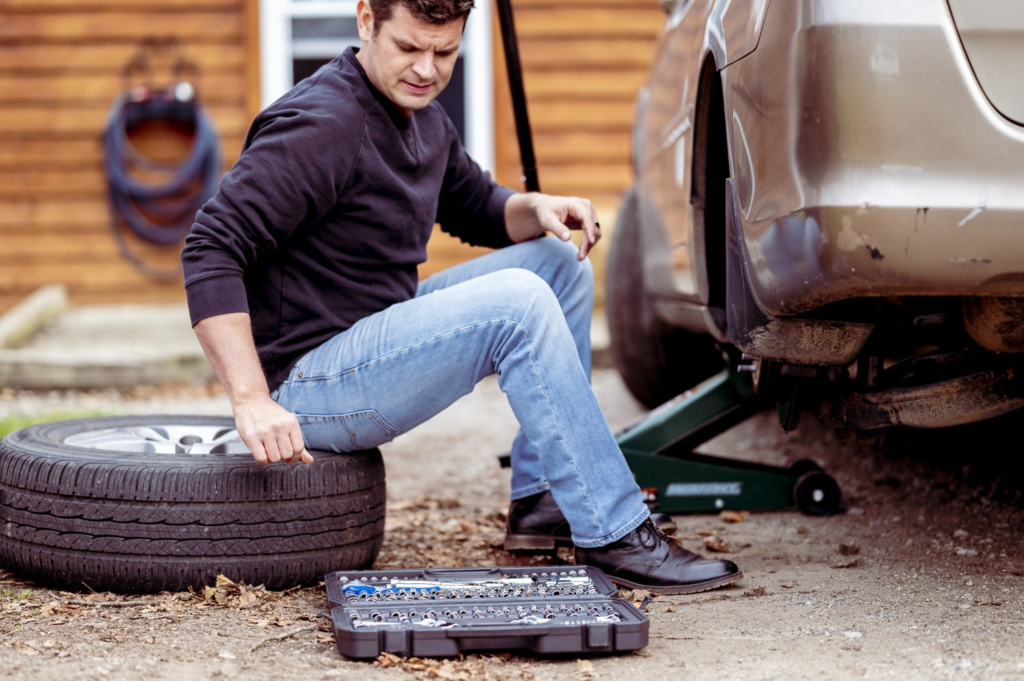A flat tire can happen at the most inconvenient time, leaving drivers stressed and unsure of what to do next. Learning how to change a flat tire is an essential skill every car owner should master. While basic knowledge is helpful, visiting our auto repair shop for tire replacement and wheel alignment ensures your vehicle stays safe, stable, and performing at its best. By combining proper tire-changing skills with professional support, you’ll feel more confident and prepared on the road.
A flat tire can also be a warning sign of deeper issues, such as worn-out tread, incorrect tire pressure, or even suspension problems. Regular maintenance and professional inspections play a key role in reducing the risk of unexpected flats. For lasting solutions and preventive care, be sure to visit our auto repair shop, where technicians can check for hidden issues and keep your vehicle running smoothly and safely.
If you’re searching for ‘auto repair near me,’ we’re here to help — book your service today.
Why It’s Important to Know Tire Changing Basics
Being able to change a flat tire is more than just convenient; it can be a lifesaver. If you are stranded in an unfamiliar area, knowing the steps can help you get moving quickly without waiting hours for assistance. It also prevents you from being fully dependent on roadside services, giving you peace of mind during long trips. With a little practice, you can avoid delays, reduce risks associated with being stuck on the side of the road, and ensure your tires and wheel alignment stay in good condition for safer driving. For ongoing care and reliability, regular tire services are also recommended to keep your vehicle in top shape.
Essential Tools You Need
Changing a tire requires some basic tools that should always be stored in your vehicle. Having them ready can save you time and ensure safety in emergencies.
- Spare Tire: Always check your spare tire regularly to ensure it is properly inflated. A flat spare won’t help you in an emergency, and routine checks prevent that problem.
- Car Jack: Used to lift your car, the jack should be placed at specific lift points indicated in your owner’s manual. Using it incorrectly can damage your car or cause unsafe lifting.
- Lug Wrench: This tool loosens and tightens the lug nuts. A four-way lug wrench provides better grip and leverage compared to a standard one.
- Wheel Chocks: These sturdy blocks keep your car from moving while it’s lifted. They are especially important if you’re on uneven ground.
- Owner’s Manual: Every vehicle has slightly different instructions. The manual helps you locate jack points and explains specific tire-changing recommendations for your car model.
Step-by-Step Guide on How to Change a Flat Tire
Changing a tire may seem intimidating at first, but once you understand the process, it becomes much easier. By following these steps carefully, you can handle the situation safely and efficiently, even if you’ve never done it before. With the right tools and a little patience, you’ll be back on the road in no time.
1. Find a Safe Location
The moment you realize you have a flat tire, slow down gradually and find a safe, flat spot away from traffic. Driving on a flat for too long can damage your rim and suspension. Turning on your hazard lights ensures other drivers can see you clearly while you work.
2. Apply the Parking Brake
Before starting any work, apply the parking brake completely. This step prevents the vehicle from rolling while lifted. Even on level ground, a car can move unexpectedly, and setting the brake ensures maximum stability.
3. Place Wheel Chocks
Position wheel chocks on the side opposite the flat tire to prevent rolling. For example, if your rear tire is flat, place the chocks in front of the front tires. This small but crucial step enhances safety and provides extra peace of mind while you’re under pressure.
4. Loosen the Lug Nuts
Use your lug wrench to slightly loosen the lug nuts before raising the car. Do not remove them completely yet. Loosening them while the tire is still in contact with the ground prevents the wheel from spinning and makes the process smoother later.
5. Raise the Vehicle with the Jack
Consult your owner’s manual to find the correct jack point near the flat tire. Place the jack firmly on solid ground and slowly lift the vehicle. The car should be raised until the tire is at least six inches off the ground, allowing enough space to remove and install the spare comfortably.
6. Remove the Flat Tire
Now, fully unscrew and remove the lug nuts. Carefully take off the flat tire and place it under the car as an extra precaution in case the jack slips. This step not only protects you but also prevents damage to your vehicle if something unexpected happens.
7. Mount the Spare Tire
Align the spare tire with the lug bolts and gently slide it into position. Make sure the holes line up properly with the bolts so that the tire sits flush against the hub. Improper alignment can lead to wobbling or unsafe driving conditions.
8. Hand-Tighten the Lug Nuts
Start threading the lug nuts by hand to avoid cross-threading, which can damage the bolts. Tightening them lightly by hand ensures they are seated correctly before you apply full force with a wrench later. This step also helps you secure the tire in place before lowering the car.
9. Lower the Vehicle and Tighten the Lug Nuts
Use the jack to carefully lower your car until the spare touches the ground. Do not lower it completely yet. Once the tire is partially supporting the car’s weight, tighten the lug nuts in a crisscross pattern. This method distributes pressure evenly, ensuring the tire is properly secured.
10. Store Tools and Check Your Spare
After tightening, fully lower the car and remove the jack. Replace the hubcap if necessary and store all tools, including the flat tire, securely in the trunk. Before driving, check the air pressure in your spare tire. Driving on an underinflated spare can be just as dangerous as driving on a flat.
Safety Tips After Changing a Flat Tire
A spare tire is usually temporary and not designed for long distances or high speeds. After installing it, you should drive carefully, avoid sudden maneuvers, and make it a priority to visit a trusted repair shop as soon as possible. Regular tire checks and preventive maintenance are the best ways to reduce the chances of future breakdowns.
1. Drive at a Safe Speed
Spare tires, especially “donuts,” are not built for highway speeds. It’s best to keep your speed under 50 mph to reduce strain on the temporary tire and maintain safe handling of your vehicle. Slower driving also gives you better control in case of emergencies.
2. Avoid Long Distances on the Spare
Most spare tires are only intended for 50–70 miles of use. Driving beyond this limit can lead to uneven wear, handling problems, and even damage to other components like brakes or suspension. Treat the spare as a short-term solution until you can get a full replacement.
3. Check Tire Pressure Immediately
Even a spare tire can lose pressure over time if it hasn’t been used or inspected recently. Driving on an underinflated spare can cause another flat or even a blowout. Always check the air pressure with a gauge before driving far.
4. Be Cautious With Braking and Turning
Spare tires don’t provide the same traction and stability as a regular tire. Avoid hard braking, sharp turns, or sudden maneuvers to minimize the risk of losing control. Gentle driving keeps both you and your car safe until a proper tire is installed.
When to Call Eric’s Car Care
Sometimes changing a tire by yourself is not safe, especially if you’re on a busy highway, at night, or if the lug nuts are too tight to loosen. In these situations, it’s best to call the professionals. At Eric’s Car Care, we provide quick tire replacement, inspections, and reliable auto repair services to keep your car in top condition. From tires to brakes and even wheel alignment, our team ensures your vehicle runs smoothly and safely.
Stay Prepared and Drive Confidently
Knowing how to change a flat tire gives you independence and peace of mind. However, for long-term care and safety, professional inspections and maintenance are essential. Trust Eric’s Car Care for expert tire services, wheel alignment, and complete auto repair services to keep your vehicle road-ready every day. So, schedule your visit today by calling 713-667-9293.

